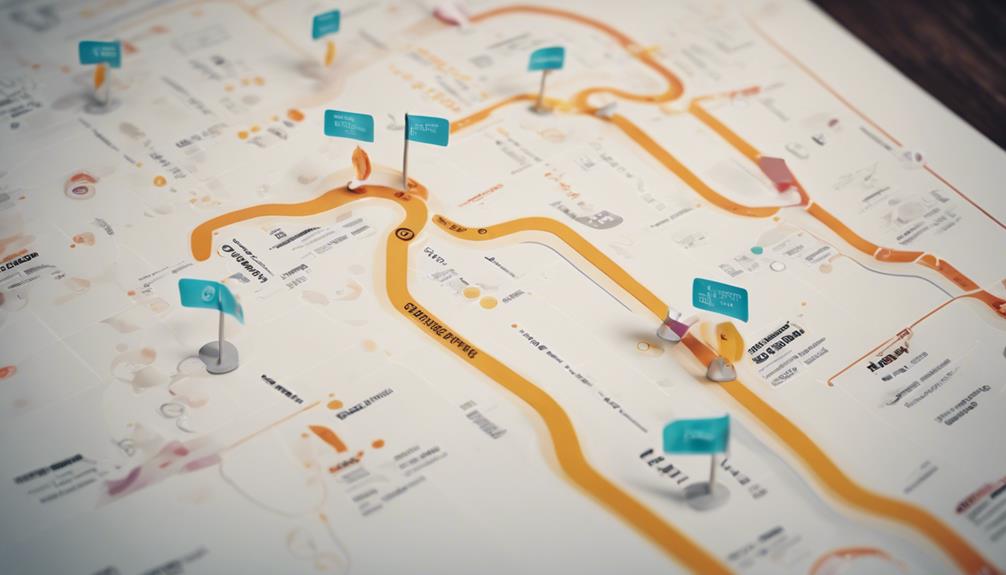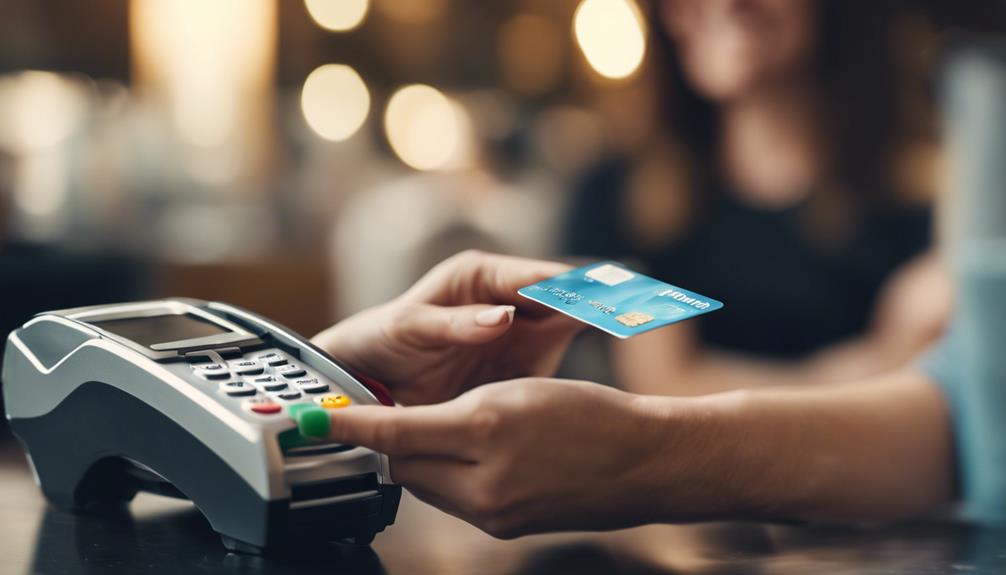To design effective loyalty programs for modern consumers, focus on aligning program objectives with business goals, fostering emotional connections, and improving retention rates. Offer unique benefits tailored to customer preferences, provide personalized rewards, and use data insights for targeted incentives. Engage customers with personalized content, recognition, and influencer collaborations. Align stakeholders, analyze data for segmentation, and leverage technology for seamless experiences. Prioritize adaptability and legal compliance for long-term success. By implementing these strategies, you can create impactful loyalty programs that resonate with today's consumers and drive sustained engagement. Loyalty program strategies should also include gathering feedback from customers to continuously improve the program, and creating a sense of community among members through exclusive events and perks. By constantly refining and innovating your loyalty program, you can stay ahead of competitors and keep customers coming back for more. Remember that the key to successful loyalty programs lies in the ability to create memorable and meaningful experiences for your customers.
Key Takeaways
- Personalize rewards based on behavior and preferences.
- Enhance engagement with tailored incentives.
- Offer customized promotions for specific needs.
- Increase retention and satisfaction levels.
- Implement flexible program structures for loyalty.
Loyalty Program Objectives

When designing loyalty programs, begin by clearly defining the objectives that align with your broader business goals to drive success and growth. Effective loyalty program objectives are vital for tracking performance and guaranteeing the program's effectiveness.
One key aspect is to establish emotional connections with customers to foster long-term relationships. This can lead to improved customer retention rates, increased average order value, and the creation of brand advocates who promote your business.
By setting measurable goals, businesses can better understand customer behavior, enabling the development of targeted marketing strategies. Aligning loyalty program objectives with your business goals not only helps in achieving short-term success but also in building sustainable, long-term relationships with your customers.
It's essential to focus on creating value for your customers while meeting your business objectives to ensure the success of your loyalty program.
Customer Value Propositions

To establish a compelling customer value proposition in loyalty programs, focus on offering unique benefits that provide exclusive access to products or services. Tailoring these propositions to connect emotionally with customers is vital to attracting and maintaining their commitment.
By personalizing value propositions based on customer preferences, you can enhance retention rates and deliver added value that resonates with your target audience. It's essential to differentiate your loyalty program from competitors by crafting a persuasive value proposition that stands out and meets the specific needs of your customers.
These customer value propositions play a significant role in driving engagement, fostering repeat business, and ultimately determining the success of your program. By providing exclusive access and demonstrating the added value your program brings, you can create strong connections with your customers, encouraging their ongoing participation and loyalty.
Targeted Incentives and Rewards

In loyalty programs, targeted incentives and rewards play a significant role in increasing customer engagement and fostering loyalty by tailoring specific rewards to individual preferences. Personalized rewards based on customer behavior and purchase history are key drivers of higher participation and loyalty.
By offering exclusive rewards and discounts to loyal customers, businesses can strengthen connections and encourage repeat business effectively. Tailoring incentives to match customer preferences is vital for the success of loyalty programs, as it leads to more impactful results. Utilizing data-driven insights can help in identifying the most effective incentives to drive customer retention and loyalty.
Modern consumers appreciate the personal touch that comes with receiving rewards tailored to their preferences, making them more likely to engage and remain loyal. By focusing on targeted incentives and personalized rewards, businesses can create a more engaging and rewarding experience for their customers, ultimately leading to increased loyalty and repeat business.
Customer Engagement Strategies

Implement personalized content and exclusive services in loyalty programs to cater to individual preferences and enhance customer engagement. By recognizing customers for non-transactional interactions, you can foster emotional connections and build loyalty. Curating content and leveraging influencer marketing are effective strategies to engage customers and make loyalty programs more impactful. Utilize social media virality and influencer collaborations to expand brand reach and further enhance customer engagement. Additionally, rewarding customer engagement with exclusive experiences and benefits not only drives loyalty but also encourages repeat business. Below is a table outlining key strategies to boost customer engagement and loyalty through personalized content and exclusive services:
| Strategy | Description | Benefits |
|---|---|---|
| Personalized Content | Tailoring content to individual preferences to create a unique and engaging experience. | Enhances customer satisfaction |
| Emotional Connections | Building strong emotional ties with customers through personalized interactions. | Fosters brand loyalty |
| Exclusive Services | Providing special services exclusively to loyalty program members to increase engagement. | Encourages repeat business |
Stakeholder Alignment Practices

Ensuring all stakeholders are aligned is a vital factor for the success of loyalty programs, with companies facing challenges in obtaining buy-in from diverse teams.
Stakeholder alignment is pivotal in the implementation of customer loyalty programs. Understanding the perspectives of various departments such as marketing, finance, and sales is essential for designing effective loyalty strategies that resonate with customers.
Successful alignment practices foster cohesive stakeholder collaboration, leading to increased program engagement and customer satisfaction.
Data Analysis and Integration

To enhance the effectiveness of loyalty programs, prioritize data analysis and integration for precise customer segmentation and tailored rewards. Customer data holds the key to understanding your audience better, allowing you to segment them accurately and offer rewards that resonate with their preferences. By leveraging data-driven approaches, you can boost customer engagement and overall program effectiveness. Integrating customer data collection into loyalty programs provides valuable insights that enable you to refine your strategies continuously.
Furthermore, technology integration plays an important role in modern loyalty programs by ensuring seamless digital experiences for customers. Adapting to changing contexts is essential; regular review and adjustment of strategies based on data and trends help keep your loyalty program relevant and engaging. By embracing data analysis, integration, and staying adaptable to evolving landscapes, you can create loyalty programs that truly connect with modern consumers and drive lasting customer relationships.
Technology Implementation Guidelines

Enhancing loyalty programs through effective technology implementation requires a strategic approach that optimizes customer engagement and personalization. Incorporating AI and machine learning can tailor rewards and offers, boosting redemption rates by 20%.
Mobile app integration is vital for engaging tech-savvy consumers, potentially increasing program participation by 65%. Implementing blockchain technology enhances program security, ensuring customer data protection and fostering trust among modern consumers.
Additionally, augmented reality experiences within loyalty programs have shown a significant impact, driving up customer retention rates by 40%.
To maximize the benefits of technology in loyalty programs, it's essential to focus on customer engagement, personalized rewards, mobile app integration, blockchain security, and augmented reality experiences. By leveraging these technological tools, loyalty programs can adapt to the preferences of modern consumers, leading to increased participation and retention rates. Remember, prioritizing program security and customer data protection is paramount in the digital age.
Program Adaptability Considerations

Consider the importance of program adaptability as you explore designing loyalty programs that resonate with modern consumers and drive sustainable engagement. To create loyalty programs that truly connect with customers, it's essential to take into account their individual needs and preferences.
Here are three key considerations for designing adaptable loyalty programs:
- Personalized Rewards: Implementing personalized rewards based on customer behavior and preferences can greatly enhance engagement and loyalty.
- Tailored Offerings: Offering tailored promotions and incentives that cater to the specific needs of customers can lead to higher satisfaction levels and increased retention rates.
- Program Flexibility: Providing flexibility within the loyalty program structure allows customers to feel valued and understood, ultimately boosting customer satisfaction and loyalty.
Legal and Ethical Compliance

When designing loyalty programs, it's essential to guarantee legal and ethical compliance. This involves meeting standards set by regulations like GDPR and CCPA, as well as considering ethical aspects such as transparency and fair treatment of customers.
Adhering to anti-discrimination laws and maintaining ethical practices not only fosters customer trust but also safeguards the brand's reputation in the long run.
Compliance Standards Overview
Adhering to compliance standards in loyalty programs is crucial for guaranteeing fairness and transparency in your operations. When it comes to compliance, there are several key aspects to take into account:
- Legal Regulations: Make sure you follow data privacy laws, anti-fraud regulations, and consumer protection statutes to protect your customers' rights.
- Ethical Guidelines: Uphold honesty, integrity, and fairness in all your interactions with customers and partners.
- Industry-Specific Regulations: Adhere to specific regulations like HIPAA in healthcare or GDPR in Europe to safeguard customer data and privacy.
Ethical Considerations Checklist
Ensuring legal compliance with data protection laws such as GDPR and CCPA is a foundational aspect of designing ethical loyalty programs. Transparency in data collection practices and consent mechanisms is vital for maintaining ethical standards in loyalty program design.
Implementing fair reward structures that are non-discriminatory helps promote ethical behavior within loyalty programs. Honoring customer privacy rights and providing opt-out options demonstrate a company's ethical responsibility to its customers.
It's essential to regularly review and update terms and conditions to align with changing regulations to guarantee ongoing ethical compliance. By considering these ethical considerations in loyalty program design, companies can build trust with their customers and foster long-lasting relationships based on honesty and fairness.
Frequently Asked Questions
How Do You Create a Successful Customer Loyalty Program?
To create a successful customer loyalty program, focus on understanding your customers' preferences and needs. Offer personalized rewards and incentives to keep them engaged.
Utilize tiered structures to encourage increased spending and loyalty. Incorporate gamification elements to enhance interaction and motivation.
Collect and use customer data responsibly to tailor offers. By combining these strategies, you can build a program that not only retains customers but also drives revenue growth and strengthens brand relationships.
What Are the Design Characteristics of an Effective Loyalty Program?
When designing an effective loyalty program, it's essential to focus on personalized rewards, engaging gamification elements, and a seamless omnichannel experience.
Building emotional connections with customers through targeted marketing strategies and data-driven insights enhances loyalty and advocacy.
By tailoring rewards to individual preferences and behaviors, you create interactive experiences that keep customers engaged.
What Are the Five Criteria for a Successful Loyalty Program?
To create a successful loyalty program, consider offering clear rewards to motivate customers. Personalize the experience, as most consumers prefer it. Keep the design simple for better understanding.
Make sure the program is accessible via mobile devices. Engage with customers regularly to maintain their interest. These five criteria can help you design an effective loyalty program that resonates with modern consumers.
What Is the Loyalty Program Design Strategy?
In loyalty program design strategy, the focus is on fostering lasting customer relationships through personalized value offerings. By leveraging data analytics, tailored rewards are provided based on individual preferences. This approach combines immediate benefits with unique experiences to build emotional ties with customers.
Upholding ethical standards is essential for preserving trust and maintaining a positive reputation within the loyalty program design framework.
Conclusion
To sum up, when developing effective loyalty programs for modern consumers, it's important to carefully plan and execute.
One interesting statistic to keep in mind is that 83% of consumers are more likely to continue doing business with companies that offer loyalty programs.
By understanding customer needs, providing targeted incentives, and utilizing technology and data analysis, businesses can create loyalty programs that drive customer engagement and retention.
Remember to stay adaptable, compliant, and aligned with stakeholder interests for long-term success.










